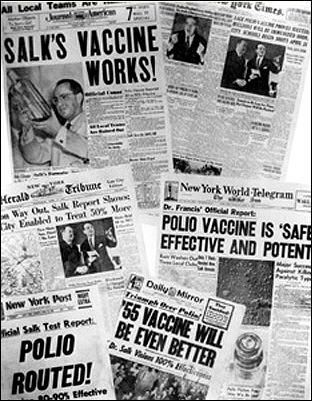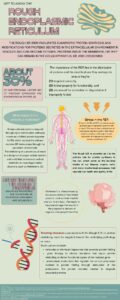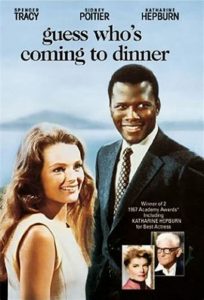—There were 58,000 cases already reported in the year of 1952, and the number quickly escalated. With no cure, no progress, and very little hope, one physician rose to the challenge of ending the Polio epidemic: Jonas Salk. Salk’s first obstacle to ending the outbreak was his need for funding and for lab equipment. After notable development with Salk’s prior research on the flu virus, the University of Pittsburgh School of Medicine gave the scientist’s ambition a spark of hope, by granting Salk with his own lab equipment. Yet, that spark quickly dimmed as the size of the lab provided, coupled with the restricting rules of the university, deterred Jonas Salk from getting much work accomplished.1 Salk struggled for over a year with limited supplies, until the world grew more desperate for a solution. Public outcry prompted the National Foundation for Infantile Paralysis to offer Salk the essential lab space, equipment, and researchers needed to investigate the polio epidemic. The increase in cases led to the possibility of more strands of the polio virus being spread across the United States and as such Salk was tasked with identifying the various strands of the virus. Finally provided with the necessary resources, Salk quickly took advantage of this opportunity and expanded the goal of his research to encompass finding a vaccine for polio.

This huge undertaking, to create a solution for polio altogether, came as no surprise to those who knew Salk, as he—referring to the latter years of his medical school career— once famously proclaimed, “…my original ambition, or desire, [was] to be of some help to humankind…in a larger sense than just on a one-to-one basis.”2 Salk’s research extended beyond a mere breakthrough. Ultimately his end “desire” was to end the spread of Polio altogether. This bigger picture mindset can be traced all the way back to Jonas Salk’s early education. He attended college at the early age of fifteen years, and Salk quickly became set apart from other students. He found himself so removed from normality that he was later documented as “a perfectionist” who “read everything he could lay his hands on” from one of the students that grew up with him.3 Salk grew up in a time where death was largely considered a regularity, as husbands, fathers, and sons returned from the savageries of World War I barely recognizable. As Salk continued his educational career, death rates, too, continued to grow as the influenza epidemic began its uproar in 1919, which was soon amplified by polio. Knowing this, it is easy to understand why an individual with Salk’s potential would seek out a field to use his intellectual talents to help humankind. Interestingly enough, Salk originally pursed a medical degree because his parents commonly urged the necessity of financial stability, which they believed was little more than an absolute requirement to live happily in a time of such chaos; and the medical field was an avenue to a stable paying career. Yet, Salk’s passion for research remained at his forefront, and, when presented with the opportunity to do research in biochemistry, he quickly took advantage of it. It is here where Salk was eventually presented with a fellowship at the University of Michigan, where, alongside Thomas Francis Jr—his mentor at the time—he would study flu viruses and later be given the opportunity to discover the polio vaccine.
When Salk received the opportunity to do research in Biochemistry, his career plans began to unfold. His high ambitions were quickly met with an equal challenge in research needed to defeat this disease altogether. Polio, by the year 1950, had reached 20,000 cases a year, and the number had escalated to 58,000 cases in the year of 1952 for the United States alone.4 The exponential growth of polio propagated a rush to find a vaccine and resulted in widespread panic across the entire globe. In an interesting perspective, Sarah Colt—a famous director of the time—explains that in a time of racial segregation, the color-blindness of the disease catalyzed even more fear across America.5 In a desperate attempt to quell the rising cases of Polio, hospitals began using devices such as the Iron Lung much more frequently. Despite common belief, the Iron Lung had previously been implemented prior to the polio epidemic and equivocated with the treatment of a polio patient. The way the machine works is by using a negative pressure gradient in a patient’s chest cavity as compared to the atmospheric pressure. The lungs then naturally receive airflow and begin to fill. Pressure is then added, causing the diaphragm to expand, expelling the air within the lungs. This device became necessary for most patients suffering from polio because the diaphragm would become paralyzed, thus leaving the patient without a way of breathing. These huge devices were very impractical because of their size, but were still widespread, reflecting the desperation everyone felt.

Desperate for progress, a few scientists neglected the appropriate procedures of the scientific method. The most famous case is that of scientist John Kolmer. John Kolmer, best known for the Carl Coolidge Jr. incident, created a vaccine that used grounded monkey spinal cords infected with polio. Kolmer would go on to use this “vaccine of sorts,” to inject more than ten thousand children in thirty-six states. Yet, Kolmer neglected to establish a control for his experiment (children not injected with the disease) and thus was left with no way to determine whether or not the vaccine actually worked. To make matters worse, several children actually developed polio soon after they received Kolmer’s vaccine. Kolmer was subsequently discredited for his work and was shunned within the scientific community. In the end, numerous children were paralyzed and even killed.6
Given a huge degree of responsibility, Jonas Salk understood the effects his work could make on a macroscopic scale. Salk dedicated his life to correctly formulating a method to end polio. As such, the funds from the National Foundation for Infantile Paralysis were used to assemble a research team to discover the vaccine. Seven years after first beginning his research, the ambition of the young medical student had finally reached the fulcrum. Dr. Jonas Salk, confident in the safety of his vaccine, began testing it in trials. Documented as “the most elaborate program of its kind in history” by historian William L. O’Neill in his book American High: The Years of Confidence, Salk’s trial involved over twenty thousand physicians and public health officials, and over two hundred and twenty thousand volunteers.7 At the height of its popularity, more than one million children between the ages of six and nine took part in the trial, and the monumental field experiment was backed not only by great confidence in the years of research Salk used to create the vaccine, but by the extent to which Salk confided in his research. Salk dedicated his entire life to discovering this vaccine, at one point going so far as to divorce his wife, claiming later that “I like to think to marry science.”8

On April 12, 1955, Salk released the final results of the field trials. Salk’s vaccine was 90% effective to PV1, PV2, and PV3.9 Additionally, bulbar polio effectiveness was at a 94%. This undoubted success was as monumental as it was unprecedented, and news of the vaccine was heard around the world. Places from Denmark to Australia alike all rushed to obtain vaccines. The surreal success of Jonas Salk’s research earned him the praise of people across the globe, who hailed Salk as a hero. In response to the world’s reaction, popular television host Edward Murrow told Salk, “Young man, a great tragedy has befallen you—you’ve lost your anonymity.”10 And Murrow was right. Jonas Salk did his best to avoid the praise and instead divert the spotlight to campaign for mandatory vaccines. Salk believed that what he had accomplished was an obligation to humanity; a job that would have had to be completed by anyone had they been in his shoes. Nonetheless, Jonas Salk took full advantage of the opportunity his newly found fame had provided to advocate for the vaccine on a grand scale. This advocacy eventually developed into the March of Dimes. While Dr. Salk never truly believed what he had accomplished should be praised, as we look back at the epidemic as a whole, it is easy to understand the potential catastrophe that was avoided had the vaccine not been developed. Thanks to his work, the annual number of polio cases within the United States dropped to only 161 by the year 1961.11
Salk’s success was brought about by the relentless persistence brought about by a dream held by his younger self. Dr. Salk understood this and sought to create an institution that provided an avenue for scientists to focus on their research and not the resources required for the labs. With the help of many supporters, but particularly the National Foundation for Infantile Paralysis, Salk was able to see his ultimate dream come true. In an interview about the future of the institute, Salk said, “In the end, what may have more significance is my creation of the institute and what will come out of it, because of its example as a place for excellence, a creative environment for creative minds.”12 Through the institute, Dr. Salk had hope that the diseases that seem impossible to cure today, will become another disease of the past; while polio’s effect left a large scar across the world, Dr. Salk’s vaccine paved the foundation for immunology as a whole.
- John Bankston, Jonas Salk and the Polio Vaccine (Bear, Delaware: Mitchell Lane Publishers, 2002), 30-32. ↵
- “Jonas Salk, M.D.: Developer of the Polio Vaccine,” Academy of Achievement (website), last modified November 27, 2018, https://www.achievement.org/achiever/jonas-salk-m-d/#interview. ↵
- Debbie Bookchin and Jim Schumacher, The Virus and the Vaccine (St. Martin’s Publishing Group, 2013), 22. ↵
- Debbie Bookchin and Jim Schumacher, The Virus and the Vaccine (St. Martin’s Publishing Group, 2013), 22. ↵
- Robert LLoyd, “A fearful disease and how it was stopped,” LA Times (website), February 2, 2009, https://www.latimes.com/archives/la-xpm-2009-feb-02-et-polio2-story.html. ↵
- Paul Offit, The Cutter Incident: How America’s First Polio Vaccine Led to the Growing Vaccine Crisis (New York: Yale University Press, 2007), 56. ↵
- William O’Neill, American High: The Years of Confidence, 1945-1960 (United States: Free Press, 1989), 137. ↵
- World of Microbiology and Immunology, 2019, s.v. “Salk, Jonas (1914- 1995).” ↵
- Encyclopædia Britannica, 2016, s.v. “Monovalent Oral Poliovirus Vaccine.” ↵
- Grace Glueck, “Salk Studies Man’s Future; Salk Studies Man’s Future Renewed Interest in His Idea,” New York Times, April 8, 1980. ↵
- World of Microbiology and Immunology, 2019, s.v. “Salk, Jonas (1914- 1995).” ↵
- “Jonas Salk, M.D.: Developer of the Polio Vaccine,” Academy of Achievement (website), last modified November 27, 2018, https://www.achievement.org/achiever/jonas-salk-m-d/#interview. ↵



31 comments
Genesis Moro Otero
I never really knew the much about the polio vaccine, until I read this article. I remembered that my grandma once told me about it. I didn’t know that the person behind it, Salk, had administered so much as over one million vaccines in his arduous trials. Now, all of his hard work paid off, he created a vaccine for such a deadly disease and in the end saved countless of lives.
Juliana Montoya
The polio epidemic seemed very severe, especially in that time period because the field of medicine was not very advanced like it is today. The fact that the disease got so severe and only one scientist decide to step up to the plate. The development of the vaccine was also very impressive given the short amount of time that it was put into use.
Arsema Abera
I remember getting my polio vaccination and dreaded the experience. I didn’t really get why I was getting the shot in the first place. But as I grew up I understood a one-minute shot is better than the suffering and death that will follow if I didn’t get it. This was a really interesting article, the struggle, and determination to bring Polio a vaccine was hard but was managed and hope the same is done with the Coronavirus pandemic as well.
Mia Hernandez
Having heard many things about polio, I never really gave the vaccine or even who made it, much thought. But, after reading this article and learning about Jonas Stalk and his work, it is amazing to know that not only was the disease being treated, but it was starting to be eradicated. It was a good idea that Stalk actually took his time in developing and testing his vaccine to ensure that it would work against the horrific disease.
Lesley Martinez
I’m glad that, even though it limited Jonas Salk’s research, the University of Pittsburg School of Medicine was the first to give Salk motivation and his own lab equipment to begin researching a cure for polio. Jonas Salk helped the world by creating a vaccine that would prevent a life-threatening illness that was killing millions of people. It’s shocking to read that John Kolmer, as a scientist did not have a control group for his experiment and caused numerous children to become paralyzed or killed. Thanks to The National Foundation for Infantile Paralysis the polio epidemic was able to be put to an end, then and today. Great article!
Jose Chaman
I never knew how the polio vaccine was created, much less who invented it. Thanks to this article I could learn that Jonas Salk discovered this wonderful vaccine to not only fight the virus, but eradicate it completely. Something amazing to know is the amount of tests that had to be done before reaching the final vaccine: millions! This shows that the perseverance of scientists is vital for these discoveries to happen.
Davis Nickle
Salk really did help the world a huge catastrophe, polio was incredibly dangerous and the world was lucky to have had a man so dedicated to the eradication of the virus. I’m glad that Salk did not jump the gun like Kolmer did and instead took the time to fully test his vaccine. I cant believe how meticulous he was with the vaccine, I was baffled to hear that he used two hundred and twenty volunteers for his experiment. He really was a hero.
Giselle Garcia
This article was a great read about the discovery of the polio vaccine. I didn’t know the person behind it, Salk, worked so hard to find the vaccine through administering over one million vaccines in his trial. His work paid off, as he found the polio vaccine, and saved countless lives with it. Without scientists discovering vaccines for harmful diseases, there could have been more people affected by them, so I thank these scientists for their perseverance to preserve global health.
Josephine Tran
Congrats on your nomination Jeremiah! I really enjoyed reading the biographical article of Jonas Salk’s successes and how he got there. It was very motivational and showed the fruits of determination and tenacity. His success was so great and impactful. It is hard to imagine what might be our current reality had Salk not stuck to his mission with the determination he had.
Lauren Keller
Jonas Salk is one of the silent hero’s we don’t hear much about, but without his breakthrough vaccine, many more lives would be lost to Polio. One thing that I found interesting was that over one million children participated in his trial, and that he even divorced his wife because he was so consumed by his work. His dedication, humility, belief that anyone would have done the same in his shoes, and tireless work really contributed to a lasting impact and breakthrough in immunology.